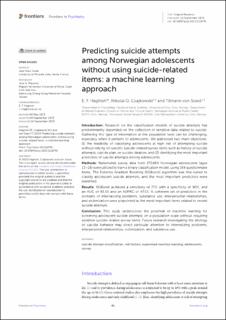| dc.contributor.author | Ebad Fardzadeh, Haghish | |
| dc.contributor.author | Czajkowski, Nikolai Olavi | |
| dc.contributor.author | von Soest, Tilmann Martin | |
| dc.date.accessioned | 2024-02-22T07:31:28Z | |
| dc.date.available | 2024-02-22T07:31:28Z | |
| dc.date.created | 2023-09-26T09:44:17Z | |
| dc.date.issued | 2023 | |
| dc.identifier.citation | Frontiers in Psychiatry. 2023, 14 . | en_US |
| dc.identifier.issn | 1664-0640 | |
| dc.identifier.uri | https://hdl.handle.net/11250/3119144 | |
| dc.description.abstract | Introduction: Research on the classification models of suicide attempts has predominantly depended on the collection of sensitive data related to suicide. Gathering this type of information at the population level can be challenging, especially when it pertains to adolescents. We addressed two main objectives: (1) the feasibility of classifying adolescents at high risk of attempting suicide without relying on specific suicide-related survey items such as history of suicide attempts, suicide plan, or suicide ideation, and (2) identifying the most important predictors of suicide attempts among adolescents.
Methods: Nationwide survey data from 173,664 Norwegian adolescents (ages 13–18) were utilized to train a binary classification model, using 169 questionnaire items. The Extreme Gradient Boosting (XGBoost) algorithm was fine-tuned to classify adolescent suicide attempts, and the most important predictors were identified.
Results: XGBoost achieved a sensitivity of 77% with a specificity of 90%, and an AUC of 92.1% and an AUPRC of 47.1%. A coherent set of predictors in the domains of internalizing problems, substance use, interpersonal relationships, and victimization were pinpointed as the most important items related to recent suicide attempts.
Conclusion: This study underscores the potential of machine learning for screening adolescent suicide attempts on a population scale without requiring sensitive suicide-related survey items. Future research investigating the etiology of suicidal behavior may direct particular attention to internalizing problems, interpersonal relationships, victimization, and substance use. | en_US |
| dc.language.iso | eng | en_US |
| dc.rights | Navngivelse 4.0 Internasjonal | * |
| dc.rights.uri | http://creativecommons.org/licenses/by/4.0/deed.no | * |
| dc.title | Predicting suicide attempts among Norwegian adolescents without using suicide-related items: a machine learning approach | en_US |
| dc.type | Journal article | en_US |
| dc.type | Peer reviewed | en_US |
| dc.description.version | publishedVersion | en_US |
| cristin.ispublished | true | |
| cristin.fulltext | original | |
| cristin.qualitycode | 1 | |
| dc.identifier.doi | 10.3389/fpsyt.2023.1216791 | |
| dc.identifier.cristin | 2178823 | |
| dc.source.journal | Frontiers in Psychiatry | en_US |
| dc.source.volume | 14 | en_US |
| dc.source.pagenumber | 9 | en_US |
| dc.relation.project | Norges forskningsråd: 288083 | en_US |
| dc.relation.project | Norges forskningsråd: 300816 | en_US |

